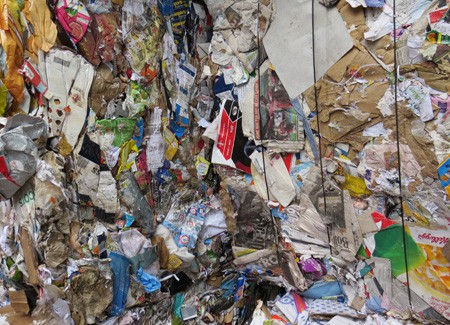Dr. Adam Read, external affairs director, SUEZ Recycling & Recovery UK takes a look at issues around contamination with a study of some of the costs that might be involved.
Nothing focuses the mind for those of us working in the recycling sector more than the post-Christmas boom of recyclable materials, the frustrations caused by changing days of collection and the overall heightened levels of public engagement as we all try to ‘get back to normal’ as quickly as possible. But the post-Christmas boom in recycling tonnage is no longer a good news story, due in part to the increasing use of unrecyclable paper and glitter laden cards, so this New Year my focus has been very much on recycling quality and contamination control, which aligns itself with the other big driver for contamination control coming from the Far East……
Now, it can’t have escaped anyone’s notice, at least not those of us working in the waste and resources sector, that the recent Chinese “National Sword” initiative has left the UK recycling sector in a great deal of uncertainty, and of course it is now live (since 1st January 2018) in terms of the restrictions being applied to incoming loads. What is clear is that the accepted level of contaminants in mixed paper and mixed plastics loads will be significantly lower than in the past, perhaps 0.5% acceptance for mixed paper from now onwards. This is going to result in a huge tidal wave through our recycling systems, with materials potentially being stuck somewhere between the producer (in our case the householder or business) and the reprocessors (wherever they may be), and this is bringing back into focus the issue of contamination, a topic which was very hot back in late 2016. And the waste management companies are sitting right in the middle of this chain, along with their local authority partners…….
Contamination counts
Recycling contamination has been a problem since the roll-out of kerbside collections, and before that with bottle banks often being used as the container of last resort for some unwanted items back in the 1980s, and came to the fore in the mid-1990s. And for as long as I have worked in the sector we have been trying to address 2 simple aspects of household recycling: [1] increase participation levels and the mix of materials being collected; and [2] ensure the right things go in the right box / container, and it seems some things just don’t change?
Now with increasing concern about the stability, availability and affordability of the end markets for the recyclate we collect, attention is turning back to minimising the recyclate we fail to capture and ensuring the recyclate we do capture is of the high possible quality to ensure it is wanted by the end markets. So whether we re-design the service, alternate weekly or new containers etc., or we focus on communications or enforcement, we need to continue the good work of the last 20 years and not overreact to this latest challenge, even though the stakes may be higher than ever before!
So why haven’t we cracked contamination yet?
If we consider the findings of research work undertaken by WRAP over the years, and learn from the experiences of local authorities and waste management companies alike, it would seem that contamination of recycling is the result of either [1] confusion by the householder (not knowing what to put out when, not knowing if something is recyclable, or seeing a recycling sign on the packaging and simply assuming it can be recycled); or [2] a total disregard for the information and instructions being provided!
So why after 20 years have we not cracked the contamination issue, when according to the Resource Association it is estimated that contamination is costing local authorities £51 million every year, and I would expect that to increase in the coming year as we struggle to source new markets for our lower grade papers and plastics? Perhaps contamination has been accepted as ‘collateral damage’ as the UK continued to expand its coverage of services and the portfolio of materials it targeted, the unfortunate consequence of asking the public to change behaviours and to engage in new systems and solutions. Well that is no longer acceptable, and with contamination levels in some local authorities as high as 15-20%, the entire affordability and financial viability of our recycling services are coming into question!

Over the last decade we have seen local authority budgets under increasing pressure, with year on year reductions, and a focus on cost-savings… often at the expense of the quality of service. This has undermined the excellent progress that had been made in recycling service design, roll-out, support and enforcement with most authorities having lower recycling communications budgets today than at any time in the last decade. So is it a surprise that contamination issues are now a common discussion at sector meetings from Bournemouth to Aberdeen? Even the best designed schemes in the world (whether commingled or source segregated systems) will suffer contamination issues if we don’t accept that residents aren’t perfect – they forget, they need time to build habits, they might delegate recycling one week to someone else in the family etc.
Pressure
So why are local authorities are under even more pressure to squeeze their communications budgets by a further £50k or £100k, leaving them with often under £1/household/year to use on all scheme related communication? Simple short term ‘maths’ is the answer…. An annual saving of £50k on the comms budget is real and can be accounted for, whilst the potential ramifications for the service’s performance is a little more uncertain and the cost impact far from guaranteed, so elected members and officers take the safe route and cut the communications budgets and resource pools. Short-sighted I hear you cry….. but all too common…..
Having run a workshop with my colleague Sarah Otterway at the LARAC’17 conference in October on contamination, the debate is just about to boil over. From the conversations we had, it was clear that the specific contamination issues faced by those we met were very similar to each other in nature (particularly those using co-mingled bins for their recycling) and that the scale of the financial burden placed on already tight budgets was ‘eye-watering’, with figures of £500,000 being quoted as the cost borne by one authority alone from contaminated recycling being delivered to their MRF operator. In this example, and many others, a lack of resources to tackle the issue may have been a false economy! So now is the time to turn the tide and re-invest in our communications programmes, to empower our recycling officers and re-engage with the public in ways that they can relate to…..
False economies and false dawns?
So how do we create a business case for more investment in communication budgets? Well, I want to keep things simple, but if contamination rates increase from say an acceptable (as per the contract) 5% (still way above the accepted levels of the Chinese market) to say 15% in 1 year what is the cost of this to an authority?
If we assume that the authority is recycling 100,000 tonnes per annum of mixed materials then the amount of contaminated material has increased from 5,000 to 15,000 and in simple terms that is an extra 10,000 tonnes of material that will need to be double-handled (having been collected from recycling and then having to be moved and disposed of) and the additional costs in terms of transport and disposal could equate to an extra £100 per tonne, resulting in an overall additional cost of £1,000,000 to the authority.
But there is also the loss of income on that 10,000 tonnes of mixed recyclables, so let’s say we lose only £20 per tonne for this material (across a number of material streams and end markets give the pain we are seeing for some materials in light of Chinese policy) that makes an additional £200,000 in losses, and potentially there will be a reduction in gate fee for the recyclables being processed because of concerns by the reprocessors about unacceptable contamination levels (let’s say a £5 per tonne reduction on the 85,000 tonnes being recycled which equals £425,000 in loss income).

So, notwithstanding that the risk on materials prices might be shared with a contractor, or passed entirely to the contractor, and that these figures are rounded and the equation somewhat simplified, the extra 10% increase in contamination levels has reduced income by £625,000 and increased expenditure by £1,000,000. Wow I hear you cry….. So wouldn’t putting 10% (say £ 160,000) of that possible ‘loss’ aside to help with targeted communications and engagement programmes make more sense than cutting the budget to make short term savings….. I think so, and perhaps your elected members might agree now, if you present the case to them?
So what can we do?
So, given the stark reality of the numbers presented, and the impending pressure from Chinese markets to reduce contamination further (and lets not assume our MRFs can cope with this on their own, even if we run them slower, employ more staff, buy new hi-tech equipment, and increase the costs significantly) what are the options open to us?
Start with a well-designed scheme, one that accepts a wide range of target materials and materials the public think are recyclable because of their labelling;
Embrace and budget for proper community engagement before any change in scheme operation or the addition of new materials, explaining why is this happening, what options were considered, how will we support you, and what the costs are of getting it wrong etc.;
Develop a good roll-out plan with strong communications and visual support on what should go in which container and why; and
Utilise targeted communications and in-street support in areas where the system is failing most (highest contamination levels, assuming you have the data to identify this) to address the problem at source, with real hand-holding type support through wardens, doctors and advisors etc.
None of this is new and the examples of good practice are plentiful, from Cannock Chase and the Suffolk Waste Partnership, to Oxford City Council and Rochdale Borough Council, just check out the WRAP website for some motivation and guidance on what you could ‘deploy’ in your area / region.
But all of these activities will cost time and money, and ring-fencing a decent communications budget, is the real challenge, so engage your budget holders and political masters early in the discussion. The evidence is there, the trends are clear…. limiting communication budgets will undermine your service and will cost you significantly more in the long term than a sensible and well used communications budget…..
Working together!

And it is not just about local authorities and those of us who provide services on their behalf; MRF operators and re-processors have their part to play too, and with the market squeeze coming from China we all need to play our part in dealing with contamination throughout the supply chain.
The best place to start is at the kerbside with the consumers, saving us from double-handling the materials and fishing out the contaminants later on in the segregation, sorting and baling processes. Perhaps we need to work together throughout the supply chain to address contamination head-on now, and not wait for some magical government intervention or authorisation of a new and enhanced WRAP ‘Recycling the possibilities are endless’ national TV, radio, multimedia, and billboard campaign?
All the research suggests that people want and need more information about their recycling services, where the recyclate goes, and the issues of contamination etc. We should give in and provide them with an appropriate level of information, updates, and feedback when bins get contaminated or when services are being changed etc. Let’s not think we know better…..
Protecting communication budgets is a key weapon in our fight against recycling rate stagnation and with markets demanding better feedstocks, we can’t afford to ignore where the material comes from. And after 20 years of fighting the good fight, we need to remember what has worked and why… contamination is a problem, but not a new one, and remember to ask yourself why is it a problem, what is the source of the problem and what can you do to address it …
I look forward to seeing some good news stories in the coming months with pressure on our recycling schemes reaching their peak post-Christmas, so don’t be shy in asking for a sensible budget for 2018-19, and use your data and my framework to argue your corner!
Note: As with all my ‘comments’ they are mine and mine alone. If you would like to get in touch or share your opinions then email me adam.read@suez.com
A simple cost benefit analysis might help provide the ammunition for the budget fight with senior managers and elected members (see our example below):
An Example of a Simple Cost Benefit Analysis:
Basic statistics
Number of households
263,000
Recycling collected:
100,000 tonnes
MRF contract rejection threshold:
5% or 5,000 tonnes
In 12 months contamination rises from 5% to 15%:
5,000 to 15,000 tonnes
Extra costs:
Handling an extra 10,000 tonnes of contaminated material at £100 per tonne
£1,000,000 per year
Losses:
Loss on income on 7,500 tonnes of rejected recyclate (assuming 25% is actual contaminants) at £20 per tonne
Reduction if gate fee of £5 per tonne on the 85,000 tonnes of processed recyclate due to concerns over its quality
£425,000
Total estimated ‘cost’ of contamination
£1.6 million
Council intervenes to reduce contamination:
Contamination campaign budget
£250,000 per year
Annual expenditure of £250,000 per year (~£1 per household per year) on communications which reduces contamination to within MRF contract threshold resulting in an ANNUAL saving of: £1.3 million.











Subscribe for free